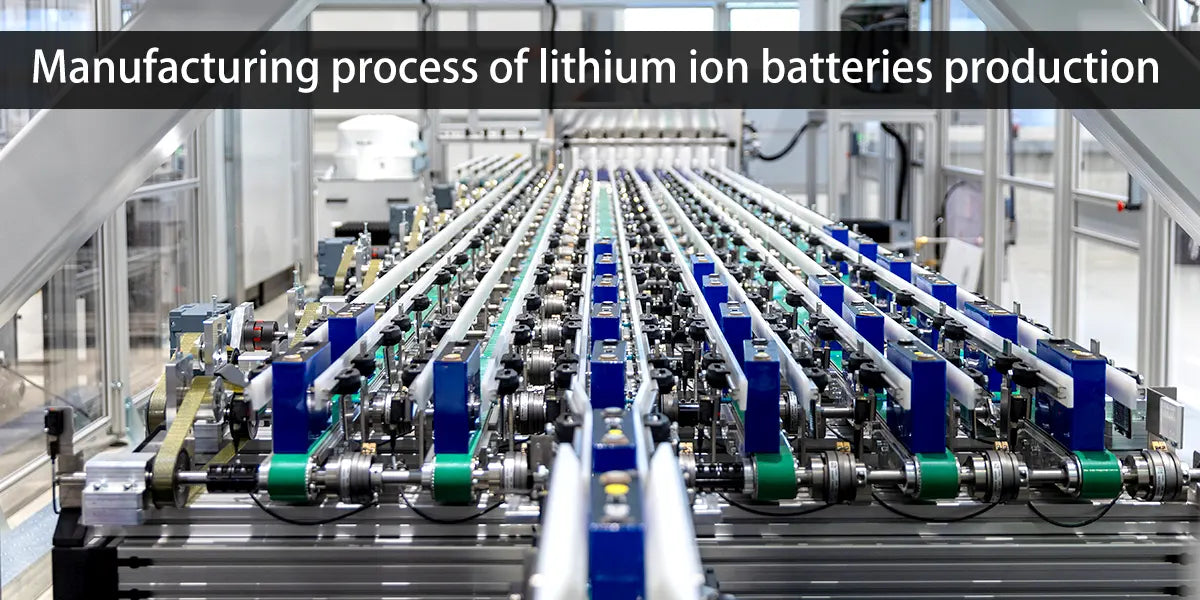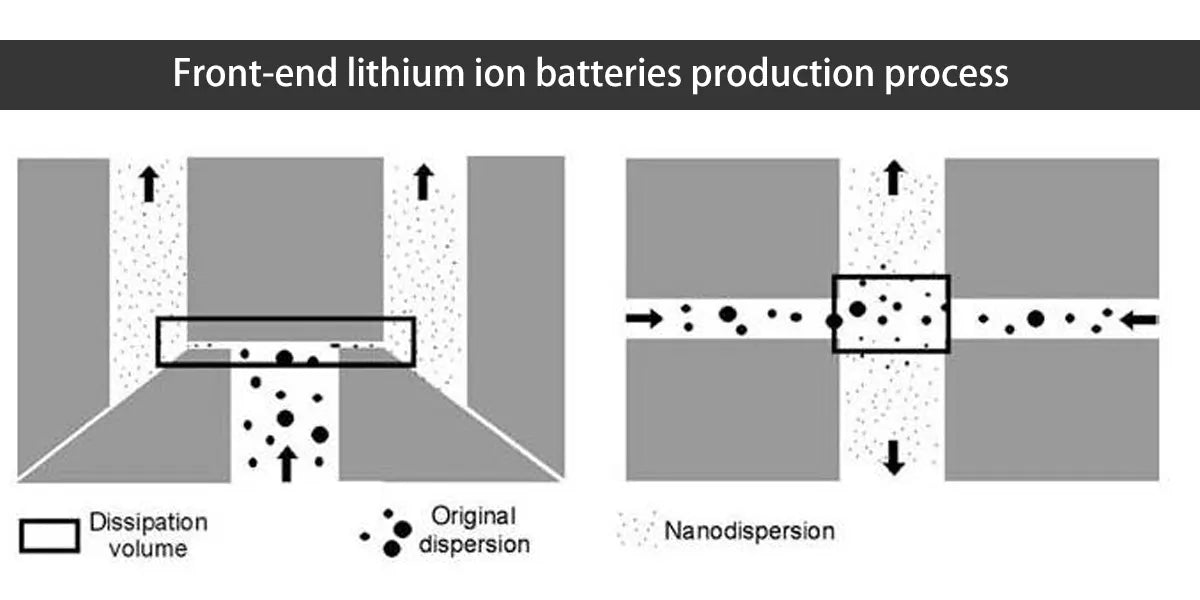
Main content:
In lithium ion batteries production, lithium batteries have unparalleled advantages in the combination of battery high energy density and power density, and are therefore widely used in various portable electronic products, power tools, and electric/hybrid vehicles.
With the continuous development of technology, various new manufacturing processes and technologies for batteries are constantly emerging. This article will provide a detailed introduction to the process of lithium ion batteries production and the basic knowledge of lithium ion battery pack. Here is a brief introduction of battery cell manufacturing, for you to catch on this article.
Lithium battery structure
The processes of different structural forms in lithium ion batteries production and materials are similar, but the equipment needs to be newly configured for different types of lithium batteries.
Lithium ion batteries are mainly composed of four parts: positive electrode, negative electrode, non-aqueous electrolyte, and battery separator. At present, the most commonly used lithium batteries in the market are lithium iron phosphate batteries and ternary lithium batteries. The difference in positive electrode raw materials between the two is significant, and the lithium ion batteries production process is relatively similar, but the process parameters need to vary greatly.
If lithium iron phosphate is completely replaced with ternary materials, the rectification effect of the old production line will be unsatisfactory. For battery manufacturers, it is necessary to replace a large area of equipment on the production line.

Manufacturing process of lithium ion batteries production
The production process of lithium batteries is relatively complex, mainly including the stirring and coating stage of electrode production (front stage), the winding and liquid injection stage of cell synthesis (middle stage), and the packaging and testing stage of chemical packaging (rear stage). The value (purchase amount) accounts for about (35-40%): (30-35)%: (30-35)%.
The differences mainly come from different equipment suppliers, differences in import/domestic ratios, etc. The process flow is basically the same, and there is a deviation in the proportion of value, but overall it conforms to this proportion.

Front-end lithium ion batteries production process
The front-end lithium ion batteries production process of lithium batteries, namely electrode manufacturing, is related to the core performance of the battery.
The result of the front-end process of lithium batteries is the completion of the preparation of the positive and negative electrode sheets. The first step is stirring, which involves mixing the solid battery materials of the positive and negative electrodes evenly, adding a solvent, and stirring them into a slurry using a vacuum mixer. The mixing of ingredients is the foundation of the subsequent process of lithium batteries, and high-quality mixing is the basis for the high-quality completion of subsequent coating and rolling processes. After the coating and rolling process, it is cut, that is, the coating is subjected to a cutting process.
If burrs are generated during the cutting process, safety hazards may arise during subsequent assembly, electrolyte injection, and even battery use. Therefore, the front-end equipment in the lithium battery production process, such as mixers, coating machines, etc., are the core machines of battery manufacturing, which are related to the quality of the entire production line. Therefore, the value (amount) of front-end equipment accounts for the highest proportion of the entire lithium battery automation production line, about 35%.

Middle section of lithium ion batteries production
Efficiency first, winding before stacking
In the manufacturing process of lithium batteries, the intermediate process mainly involves the formation of the battery, including sheet making, pole piece winding, die-cutting, cell winding and forming, and laminated forming. It is currently a fiercely competitive field among domestic equipment manufacturers, accounting for about 30% of the value of lithium battery production lines.
At present, there are two main lithium ion batteries production processes for power lithium batteries: winding and stacking. The corresponding battery structure forms are mainly cylindrical and square, and soft pack. Cylindrical batteries and square batteries are mainly produced by winding process, while soft pack batteries are mainly produced by stacking process. Cylinders are mainly represented by 18650 and 26650, while the difference between square and soft packaging lies in the use of two types of shells: hard aluminum shell and aluminum-plastic film. Among them, soft packaging mainly uses laminated technology, while aluminum shell mainly uses winding technology.
The soft pack structure is mainly aimed at the mid to high end digital market, with a high profit margin per unit product. Under the same production capacity conditions, the relative profit is higher than that of aluminum shell batteries. Due to the easy formation of economies of scale in aluminum shell batteries, the product qualification rate and cost are easy to control. Currently, both have considerable profits in their respective market fields, and it is difficult for them to be completely replaced in the foreseeable future.
Due to the fact that the winding process can achieve high-speed production of battery cells through rotational speed, while the speed that can be improved by laminating technology is limited, the current domestic power lithium battery mainly adopts the winding process. Therefore, the shipment volume of winding machines is currently greater than that of laminating machines.

Later stage of lithium ion batteries production
In lithium ion batteries production, the later stage mainly includes four steps: capacity division, chemical conversion, testing, and packaging, accounting for about 35% of the value of the production line. As the most important steps in the later stage of the process, chemical conversion and capacity separation are used to activate and detect the formed battery. Due to the long charging and discharging testing cycle of the battery, the value of the equipment is the highest.
The main function of the chemical conversion process is to charge and activate the encapsulated battery cells, while the capacity separation process tests the battery capacity and other electrical performance parameters after activation and classifies them. The chemical conversion and capacity separation are usually completed by automated capacity separation systems, with chemical conversion machines and capacity separation machines respectively.

The lithium battery pack process of the system
The power battery pack system is a battery pack that connects numerous individual cells in series or parallel, integrating battery hardware systems such as power and thermal management.
In lithium ion batteries production, pack is the key to the production, design and application of power battery systems, and is the core link connecting upstream battery cell production and downstream vehicle application. The design requirements are usually proposed by battery manufacturers or automobile manufacturers, and are usually completed by battery manufacturers, automobile manufacturers or third-party pack manufacturers.
The lithium battery pack production line is relatively simple, with core processes including feeding, bracket bonding, welding, and testing. The core equipment includes laser welding machines and various bonding and testing devices. At present, major lithium battery equipment manufacturers have relatively few automation integration layouts in this field, while laser equipment manufacturers such as Dazu Laser and Lianying Laser have a higher market share in the Pack equipment field due to their absolute advantage in the laser field.
At present, the automation rate of Pack production is relatively low because the current sales of single models of new energy vehicles are not large enough, and the cost of using automated production lines is high.

Conclusion
This article systematically outlines the core processes and key technologies of lithium ion batteries production. Lithium batteries are widely used in electronic devices, power tools, and new energy vehicles due to their high energy density and power density. The manufacturing process is divided into three stages: front, middle, and back. In the future, with material innovation (such as competition between ternary and lithium iron phosphate routes) and process optimization, lithium battery manufacturing will continue to develop towards high efficiency and precision, while winding and stacking processes, soft pack and aluminum shell batteries will still coexist in parallel according to application scenarios.
Related articles: Top 10 power battery cell manufacturers, Top 10 lithium power battery cell can companies in the world, Top LiFePo4 power battery companies in the world